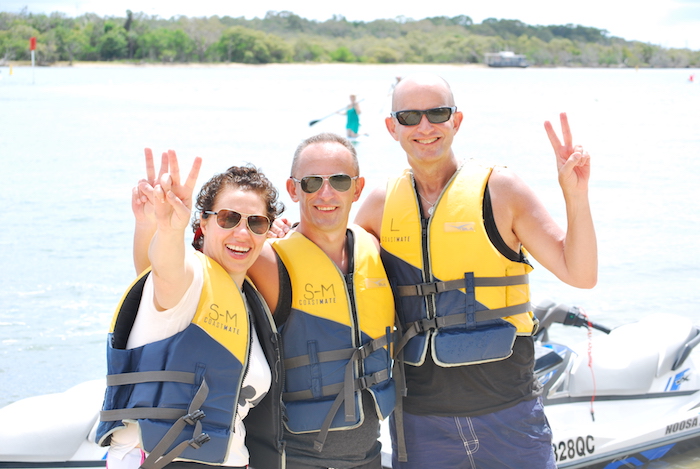Cunard Around-the-World Cruise Highlights Week 10: South Korea to Nagasaki and Kagoshima
This is the story and highlights of week ten of my around-the-world trip as travelled on Cunard’s Queen Elizabeth to Busan in South Korea and onto Nagasaki and Kagoshima in Japan. I travelled around the world in a 12-week trip that started in Southampton UK and ended in Hong Kong. Most of it on segments of Cunard World cruise, first on Queen Victoria and then Queen Elizabeth. This 12-part series covers the journey, experiences and tips – one for each week of the journey. This post covers week ten, you can read the previous week nine here.
South Korea to Nagasaki and Kagoshima in Japan
Day 64 (14 March) At sea en route to Busan, South Korea
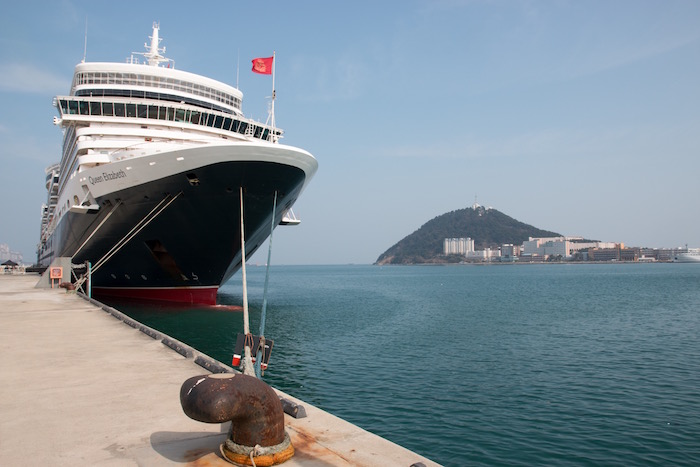
Cunard Queen Elizabeth
It was a chilly and windy day when I got up (around 6.30am) and saw the Pilot boat pull up along Queen Elizabeth. We disembarked the pilot that had been with the ship from our departure from Shanghai (around 2am). There was a line of ships behind us, with the pilot boat picking up from those too. It looked like we had departed Shanghai in a convoy – which I assumed is what happens all day to get the busy traffic down the river to and from the world’s busiest port.
We had to collect our passports from a desk during the morning, as we need them for immigration in South Korea tomorrow.
As we settled into the ship the feeling of being disoriented and unsettled started to subside. Changing ships on our lengthy trip had proved to be more jarring than I had expected, and I had to stop myself comparing everything to the Queen Victoria.
Country Fair
In the daily program the ship started advertising for guests to give freshly laundered and good condition clothes or other articles. These would eventually be sold as part of a country fair to be held later during the world cruise to raise funds for charities Cunard support.
Day 65 (15 March) Busan, South Korea
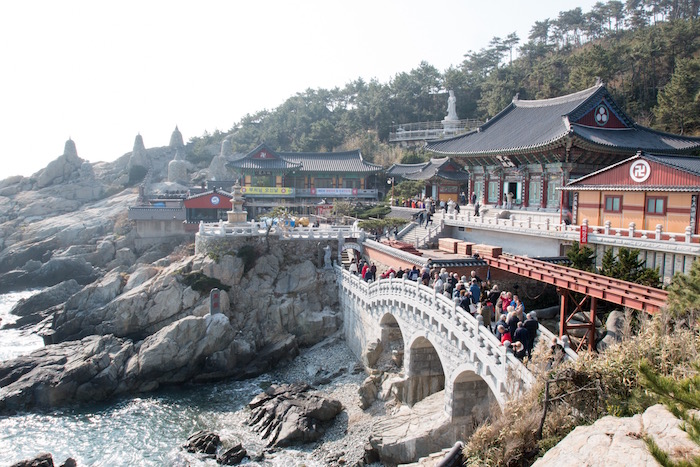
Haedong Yonggungsa Temple Busan South Korea
We docked around 8am in the port of Busan, one of the world’s five busiest container ports. They ship out the vast quantities of products like electronics and cars produced in South Korea – while importing pretty much everything South Korea needs. Low on natural resources the country relies on bringing in most of what it needs.
During the Korean War, Busan area was at one point the only part of the Korean Peninsula not occupied by the North Korean forces. It acted as a temporary capital before the United Nations and American forces pushed them back. Technically South Korea is still at war as only an armistice was signed back in 1953. Over the last 40 years the country has developed from a war ravaged one with little commercial activity into a major IT and technology-based powerhouse and exporter.
Every guest planning to go out on land in this stop, and our next in the country, had to pass through Immigration and get their passport stamped. This was a fairly smooth process in the modern cruise terminal on our way out on tour.
Our tour first took us to the Haedong Yonggungsa Buddhist Temple, about 45 minutes from the port. Afterwards we visited the APEC building, was built to host a major meeting of leaders from around the world (which seems an extravagant thing to do). It was in a gorgeous park close to a massive modern high-rise development of apartments and offices. From there we headed to a buffet lunch at a hotel before going to the famous Jagalchi Market Fish Market, where elderly women staff the stands. We explored the nearby International Market before returning to the ship. Busan is a fast developing city with a rapid growth in tourism, mostly Chinese, and large areas are being developed to cater for this growth.
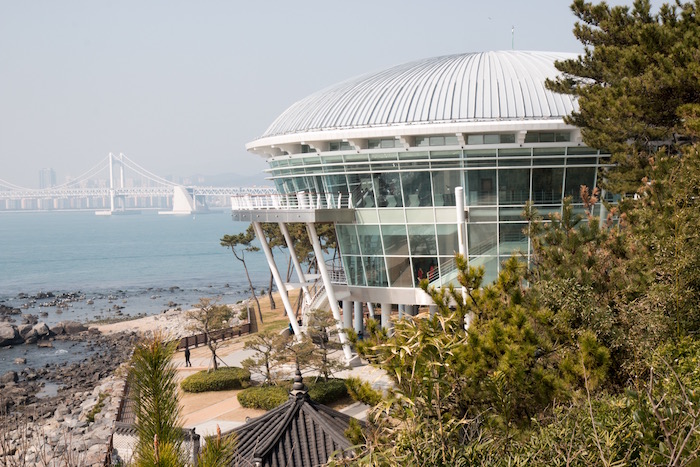
APEC House Busan South Korea
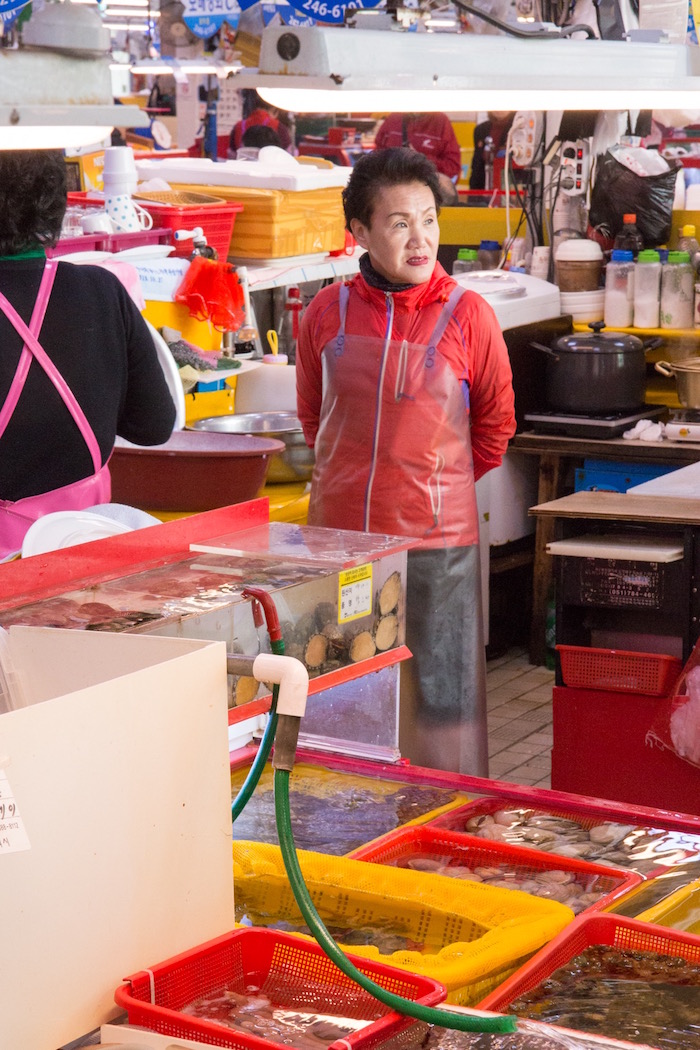
Jagalchi Market Busan South Korea
It was a late departure (7.30pm) with a slightly bizarre dockside show put on before we left. It involved scantily clad girl drummers performing to contemporary pop tracks followed by a traditional song troupe. As it was fairly chilly and most passengers were back on the ship with many at First Sitting, very few passengers watched the show.
Day 66 (16 March) JeJu-do Island, South Korea

JeJu Island Dressing up..
This was a short stop with an all aboard time of 3.30pm, despite it being a maiden call for Queen Elizabeth. We docked just after 7.30am and the all clear to leave was given at 8am. Although the island is supposed to be picturesque, the dock area was not attractive. We caught the shuttle bus into town and visited an interesting reconstruction of the traditional government compound from 1300s (where we got to dress up in traditional gear), strolled down to the Dongsum market (which seemed to mostly sell oranges, orange-based confectionary and fish) and through the underground Mall with over 280 shops.
I had a chest infection and was feeling a bit rough and so had visited the Medical Centre and seen the doctor. It costs $95 in hours plus the costs of medicines, so about the level of private GP visit in the UK.
Day 67 (17 March) Nagasaki, Japan
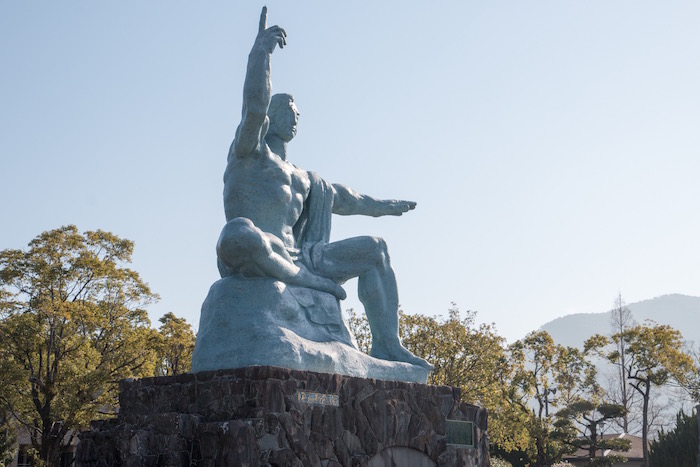
Peace Park Nagasaki Japan
Nagasaki was an amazing port to visit and a great introduction to Japan as our first stop in the country. The day dawned with bright blue skies and sunshine, and proved to be a warm day for the time of year – reaching around 20 degrees. We had to discard the coats we though we would need out on tour, and many passengers returned to the ship red and sunburnt.
Being a new country visited, we had to endure the process of Immigration and customs again. The tours had to meet earlier than usual, and we had to be in the Royal Court Theatre by 7.30am for our 8.30 trip. The process was fairly smooth, despite having to do fingerprints and photographs, with priority given to the tours. Independent Guests had to collect a group number and wait in the Queens Room.
Nagasaki is best known as where the second Atomic Bomb was dropped by the Americans during World War II in August 1945. It exploded 500 metres above the city and killed 75,000 and injured the same about. The city was decimated. It is also the last city to have been bombed by such a bomb. The city has a long history as a trading port, and even during the years of Japanese isolation it had an island that allowed foreign traders, mostly Dutch, to use. Today it has fishing, shipbuilding and tourism as its main industries.
Our tour was fascinating with a visit to the Peace Park, with statues gifted by countries from around the world promoting peace. The most impressive though was the vast man with outstretched arms that the park is known for. From there we went to the Atomic Museum (which had some harrowing images), Ground Zero Park where the bomb detonated and then we up the cable car to the summit of Mount Inasa for spectacular views of the city and out to the sea on the other side.
After returning to the ship and having lunch, we ventured out into the city. The Cruise Terminal is in town and so there was no shuttle bus. It was possible to walk up to the Glover Gardens. This is the site of the home of a Glasgow entrepreneur who is credited with having a major influence on modernising Japan bringing railway locomotives, ship building (that developed into Mitshibish Corporation) and other innoavtions. In the beautiful gardens was his house and then other historic Western-style houses that have been relocated here.
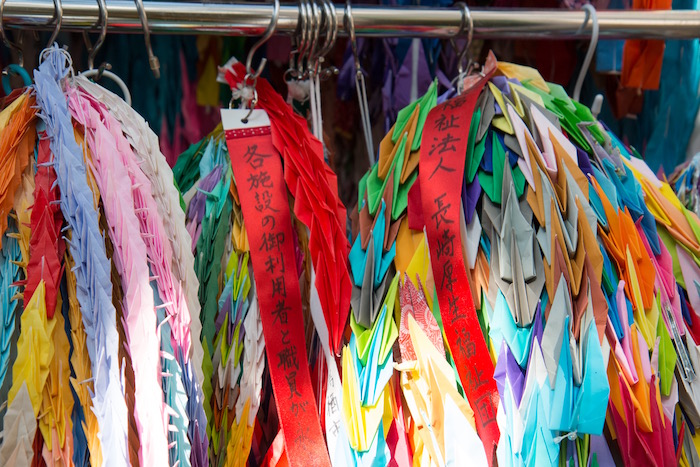
Nagasaki Atomic Museum 1,000 Cranes Garlands
At 5pm back on the ship was a delightful show by 5 and 6-year old local children of song and dance, along with a welcome speech by the Deputy Mayor to the Captain and giving of gifts. Just before we departed a secondary school brass band played songs on the quayside and as we left.
Nagasaki was beautiful, welcoming and fascinating.
Day 68 (18 March) Kagoshima, Japan
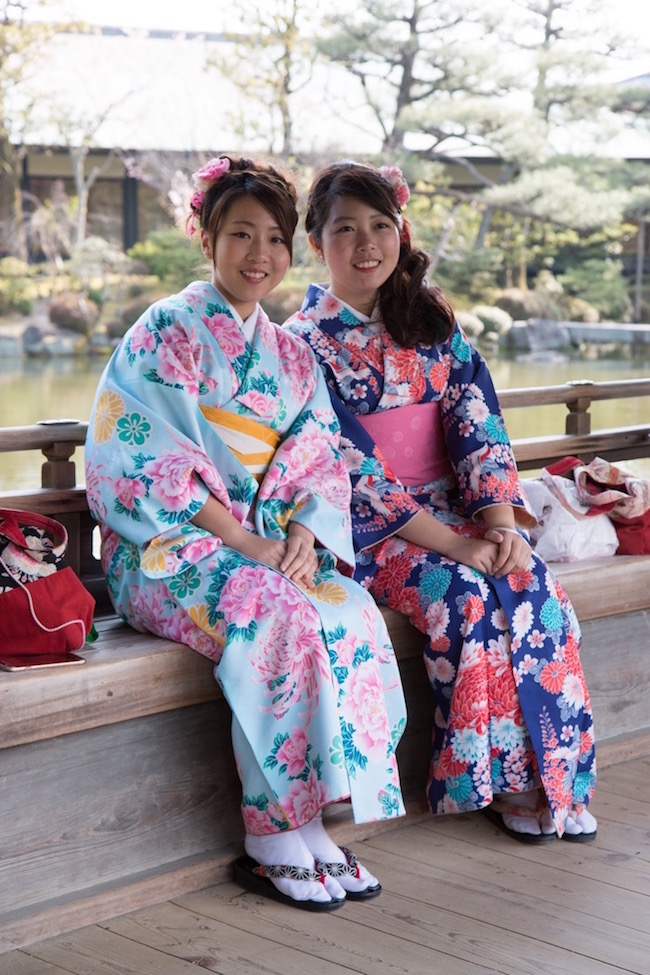
Girls dressed in Kimonos Japan
The rain was pouring down and the clouds hugged down to the lower reaches of the vast Sakurajima volcano as we sailed into Kagoshima, and yet we were greeted again by huddles of local people lining up along the quayside with umbrellas and rain suits. They shouted “Good Morning” and “Welcome” as we passed by and came to berth. A band played and the throng waved at passengers coming out on their balconies to see what was going on.
At every port in Japan it was clear that the cities went to great effort to make passengers feel welcome in their home. There were performers, local city ambassadors, and citizens that around all day. Stalls selling local handicrafts were set up and many cities, like Kagoshima, laid on activities like the chance to get dressed in kimonos or as Samurai Warriors.
Unfortunately though, unlike the day before in Nagasaki, it rained heavily all day. The landfill area next to the cruise terminal became so waterlogged from the constant rain it almost looked like the sea was claiming it back.
Kagoshima is a large city on the western tip of Kyushu island in the south of Japan. It is known for the vast Sakurajima volcano, which is still active, and the feel and look of the city has led it to be nicknamed “Naples of the East”. The tours that headed off to sightsee the volcano did not see much and we were pleased we had decided to just use the shuttle bus into the centre of town. It took about 30 minutes and we appreciated that we were in a foreign in country as there was very little English signage and people able to speak it. This was great as we felt we were really visiting someone not overrun by western tourists. We braved a local restaurant where no English was spoken or available and through pointing at food and gestures we had a great meal.
A brass band played despite the pouring rain and lots of locals were there to shout and wave us off. We felt very welcome.
Royal Cunard Singers and Dancers
The entertainment on this leg was a great disappointment after our seven weeks on the Queen Victoria. The singers were weak, and the shows all seemed to be the old-school ones with endless compilations of songs from the 50s and 60s and stuck on the past. The dancing was fine but dated and all felt jaded and past its sell by date. Even the guest entertainers were of the same ilk with endless 50s and 60s songs or highlights from “Phantom of the Opera” and “Les Miserables” rolled out by almost everyone. It was frustrating to see the stuffy and uninspired fare still alive. I had hopes from our time on Victoria that things were starting to shift….
Day 69 (19 March) At sea en route to Yokohama
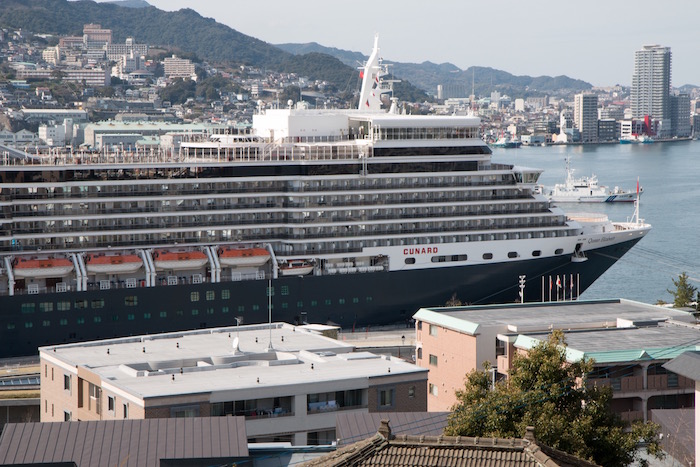
Cunard Queen Elizabeth in Nagasaki Japan
After four port days the break of one sea day before our call into Yokohama for Tokyo was welcome. People used the time to recharge, and so events around the ship were fairly quiet.
Change in feel of ship and its role when so port intensive
Having such a port intensive trip made our time on board feel quite different to the legs on Queen Victoria, which were more biased towards sea days as we travelled the vast distances to get a round the world. The relationships with other guests do not have as much time to be triggered and built, and we often missed two of the meals in the restaurant (as early starts for tours meant having breakfast in the room and being out for lunch). The ship became more of a hotel than a destination in its own right. There was less of a routine to slip into, and time passed especially quickly. Including the whole leg – as it was staggering to realise that tomorrow was already half way through the 20-night leg.
The journey continues
Keep following the trip with the week eleven article (to come) and get all the content from the trip at tipsfortravellers.com/bigtrip
Discover more from Tips For Travellers
Subscribe to get the latest posts sent to your email.



